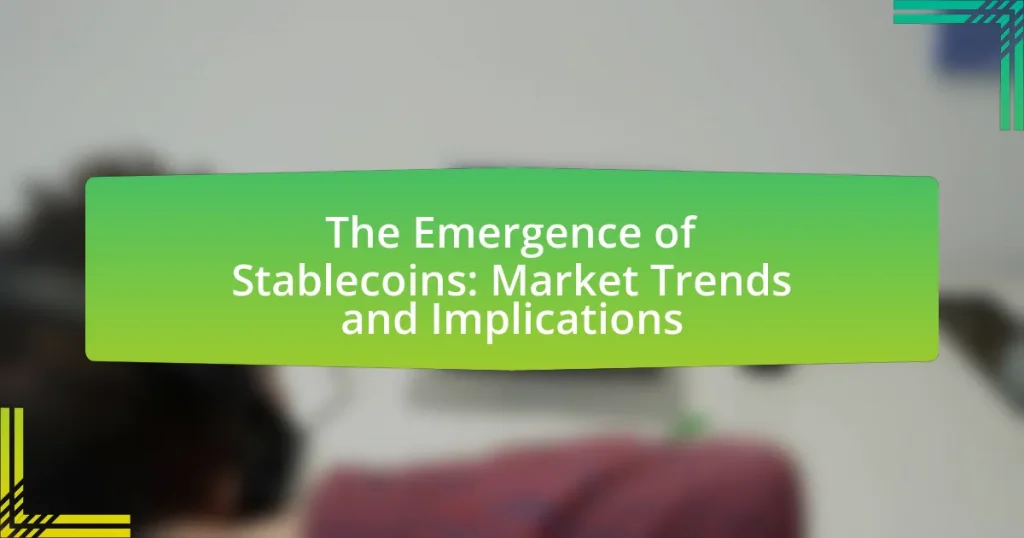Stablecoins are a type of cryptocurrency designed to maintain a stable value by pegging their worth to reserves of assets, such as fiat currencies or commodities. This article explores the emergence of stablecoins, highlighting their role in providing price stability in the volatile cryptocurrency market, facilitating cross-border payments, and enhancing financial inclusion. It examines the differences between stablecoins and traditional cryptocurrencies, the mechanisms used to maintain their stability, and the increasing demand for these digital assets. Additionally, the article discusses the various types of stablecoins, current market trends, regulatory implications, and the potential impact of stablecoins on global financial systems.

What are Stablecoins and Why are They Emerging?
Stablecoins are a type of cryptocurrency designed to maintain a stable value by pegging their worth to a reserve of assets, such as fiat currencies or commodities. They are emerging due to the increasing demand for price stability in the volatile cryptocurrency market, enabling users to transact and store value without the risk of significant fluctuations. According to a report by the Bank for International Settlements, stablecoins can facilitate cross-border payments and enhance financial inclusion, which further drives their adoption.
How do Stablecoins differ from traditional cryptocurrencies?
Stablecoins differ from traditional cryptocurrencies primarily in their price stability, as they are typically pegged to a stable asset like fiat currency or commodities. This peg allows stablecoins to maintain a consistent value, reducing volatility compared to traditional cryptocurrencies such as Bitcoin or Ethereum, which can experience significant price fluctuations. For instance, Tether (USDT) is pegged to the US dollar, aiming for a 1:1 value ratio, while Bitcoin’s price can vary widely within short time frames. This characteristic makes stablecoins more suitable for transactions and as a store of value in everyday use, contrasting with the speculative nature of traditional cryptocurrencies.
What mechanisms are used to maintain the stability of Stablecoins?
Stablecoins maintain their stability primarily through collateralization, algorithmic mechanisms, and reserve management. Collateralized stablecoins are backed by assets such as fiat currencies or commodities, ensuring that each stablecoin issued is redeemable for a specific amount of the underlying asset, which helps maintain its value. For example, Tether (USDT) is pegged to the US dollar, with reserves held to back its issuance. Algorithmic stablecoins, on the other hand, use smart contracts to automatically adjust supply based on market demand, effectively stabilizing their price without direct collateral. An example is TerraUSD, which adjusts its supply through algorithms to maintain its peg. Additionally, reserve management involves maintaining sufficient liquidity and transparency in the reserves to instill confidence among users, as seen in the practices of Circle with USDC, which undergoes regular audits to verify its reserves. These mechanisms collectively ensure that stablecoins can maintain their intended value amidst market fluctuations.
Why is the demand for Stablecoins increasing in the market?
The demand for stablecoins is increasing in the market primarily due to their ability to provide price stability in the volatile cryptocurrency landscape. As cryptocurrencies like Bitcoin and Ethereum experience significant price fluctuations, investors and users seek stablecoins as a reliable medium of exchange and store of value. According to a report by CoinMarketCap, the market capitalization of stablecoins surpassed $150 billion in 2021, reflecting a growing preference among traders for assets that minimize risk while maintaining liquidity. This trend is further supported by the increasing adoption of decentralized finance (DeFi) platforms, where stablecoins serve as essential collateral for lending and borrowing activities, enhancing their utility and demand.
What types of Stablecoins are currently available?
There are three main types of stablecoins currently available: fiat-collateralized stablecoins, crypto-collateralized stablecoins, and algorithmic stablecoins. Fiat-collateralized stablecoins, such as Tether (USDT) and USD Coin (USDC), are backed by reserves of fiat currency, typically the US dollar, ensuring a 1:1 value ratio. Crypto-collateralized stablecoins, like DAI, are backed by other cryptocurrencies and utilize smart contracts to maintain their peg. Algorithmic stablecoins, such as Ampleforth, use algorithms to control supply and demand, adjusting the coin’s supply to stabilize its price without collateral. These categories reflect the diverse mechanisms stablecoins employ to maintain price stability in the cryptocurrency market.
What are fiat-collateralized Stablecoins and how do they work?
Fiat-collateralized stablecoins are digital currencies that are backed by a reserve of fiat currency, such as the US dollar or euro, held in a bank account or with a trusted custodian. These stablecoins maintain a 1:1 peg to the fiat currency, meaning that for every stablecoin issued, an equivalent amount of fiat currency is held in reserve, ensuring stability in value.
The mechanism of fiat-collateralized stablecoins involves the issuance of tokens that represent the fiat currency held in reserve. When users purchase stablecoins, the corresponding amount of fiat is deposited into the reserve, and when users redeem stablecoins, the equivalent fiat is withdrawn. This process is typically managed by a centralized entity that ensures transparency and compliance with regulations, often providing regular audits to verify the reserves. Examples of fiat-collateralized stablecoins include Tether (USDT) and USD Coin (USDC), both of which are widely used in cryptocurrency markets for trading and as a stable store of value.
What are crypto-collateralized Stablecoins and their unique features?
Crypto-collateralized stablecoins are digital currencies backed by cryptocurrency assets to maintain price stability. These stablecoins utilize mechanisms such as over-collateralization, where the value of the collateral exceeds the value of the stablecoins issued, ensuring that even in volatile market conditions, the stablecoin can maintain its peg to a fiat currency. Unique features include decentralized governance, which allows users to participate in decision-making processes, and the ability to leverage smart contracts for automated management of collateral, enhancing transparency and security. For example, platforms like MakerDAO use Ethereum as collateral, demonstrating the effectiveness of this model in maintaining stability while allowing users to retain ownership of their assets.
What are algorithmic Stablecoins and how do they function?
Algorithmic stablecoins are cryptocurrencies designed to maintain a stable value by using algorithms and smart contracts to control supply and demand. They function by automatically adjusting the supply of the stablecoin in response to price fluctuations, often through mechanisms such as minting or burning tokens. For example, if the price of the stablecoin rises above its target value, the algorithm may increase supply by minting more tokens, thereby lowering the price. Conversely, if the price falls below the target, the algorithm may reduce supply by incentivizing users to burn tokens. This self-regulating mechanism aims to provide price stability without the need for collateral backing, distinguishing algorithmic stablecoins from other types that are pegged to fiat currencies or assets.

What are the Current Market Trends Surrounding Stablecoins?
Current market trends surrounding stablecoins indicate a significant increase in adoption and regulatory scrutiny. As of 2023, the total market capitalization of stablecoins has surpassed $150 billion, reflecting their growing role in the cryptocurrency ecosystem. Major players like Tether and USD Coin dominate the market, accounting for over 80% of the total stablecoin supply. Additionally, regulatory bodies in various countries are intensifying their focus on stablecoins, with the European Union proposing the Markets in Crypto-Assets (MiCA) regulation to establish a comprehensive framework. This regulatory attention aims to address concerns related to consumer protection, financial stability, and anti-money laundering. Furthermore, the integration of stablecoins into decentralized finance (DeFi) platforms continues to expand, facilitating lending, borrowing, and trading activities. These trends highlight the evolving landscape of stablecoins as they become increasingly embedded in both traditional and digital financial systems.
How are Stablecoins influencing the broader cryptocurrency market?
Stablecoins are influencing the broader cryptocurrency market by providing price stability, which enhances liquidity and facilitates trading. Their pegged value to fiat currencies allows traders to avoid volatility associated with traditional cryptocurrencies, making it easier to enter and exit positions. For instance, as of October 2023, Tether (USDT) and USD Coin (USDC) account for a significant portion of trading volume on major exchanges, demonstrating their role in market liquidity. Additionally, stablecoins enable decentralized finance (DeFi) applications by serving as collateral for loans and liquidity pools, further integrating them into the cryptocurrency ecosystem. This integration has led to increased adoption and trust in the cryptocurrency market overall.
What role do Stablecoins play in decentralized finance (DeFi)?
Stablecoins serve as a crucial bridge between traditional finance and decentralized finance (DeFi) by providing price stability in a volatile cryptocurrency market. They enable users to transact, lend, and borrow assets without the risk of significant value fluctuations, which is essential for maintaining liquidity and facilitating trading on DeFi platforms. For instance, according to a report by the Bank for International Settlements, stablecoins accounted for approximately 80% of the trading volume on decentralized exchanges in 2021, highlighting their importance in enabling seamless transactions and fostering user confidence in DeFi ecosystems.
How are Stablecoins being adopted by traditional financial institutions?
Stablecoins are being adopted by traditional financial institutions primarily for their ability to facilitate faster and cheaper cross-border transactions. Major banks and financial entities, such as JPMorgan and Goldman Sachs, have begun integrating stablecoins into their payment systems to enhance liquidity and reduce transaction costs. For instance, JPMorgan executed its first cross-border cryptocurrency transaction using its own stablecoin, JPM Coin, demonstrating a practical application of stablecoins in real-world banking operations. This trend is supported by the increasing demand for digital assets and the need for stable, reliable forms of currency in the evolving financial landscape.
What are the regulatory implications of Stablecoins?
The regulatory implications of stablecoins primarily involve concerns regarding consumer protection, financial stability, and anti-money laundering (AML) compliance. Regulatory bodies, such as the Financial Stability Oversight Council (FSOC) in the United States, have expressed that stablecoins could pose risks to the financial system if not properly regulated, particularly due to their potential to facilitate systemic risks during market stress. Additionally, the European Union has proposed the Markets in Crypto-Assets (MiCA) regulation, which aims to create a comprehensive framework for the issuance and operation of stablecoins, ensuring they meet specific requirements for transparency and reserve backing. These regulatory measures are designed to mitigate risks associated with stablecoins while promoting innovation in the financial sector.
How are governments and regulators responding to the rise of Stablecoins?
Governments and regulators are increasingly implementing frameworks to oversee the rise of stablecoins. For instance, the European Union proposed the Markets in Crypto-Assets (MiCA) regulation, aiming to create a comprehensive regulatory framework for digital assets, including stablecoins, to ensure consumer protection and financial stability. In the United States, the Financial Stability Oversight Council (FSOC) has identified stablecoins as a potential risk to the financial system, prompting discussions on regulatory measures to mitigate these risks. Additionally, countries like China have accelerated their central bank digital currency (CBDC) initiatives in response to the growth of stablecoins, aiming to maintain monetary control. These actions reflect a global trend towards establishing regulatory clarity and oversight in the stablecoin market.
What challenges do Stablecoins face in terms of compliance and regulation?
Stablecoins face significant challenges in compliance and regulation due to their unique structure and the evolving nature of cryptocurrency laws. Regulatory bodies often struggle to classify stablecoins, leading to uncertainty regarding their legal status, which can hinder their adoption and integration into the financial system. For instance, the lack of clear guidelines on whether stablecoins should be treated as securities, commodities, or currencies complicates compliance efforts for issuers. Additionally, concerns about anti-money laundering (AML) and know-your-customer (KYC) regulations pose challenges, as stablecoin transactions can be pseudonymous, making it difficult for regulators to track illicit activities. Furthermore, the potential for stablecoins to disrupt traditional financial systems raises apprehensions among regulators, prompting calls for stricter oversight and regulatory frameworks. These factors collectively contribute to the compliance and regulatory hurdles that stablecoins must navigate to achieve broader acceptance and legitimacy in the financial landscape.

What are the Implications of Stablecoins for the Future?
Stablecoins have significant implications for the future of finance, particularly in enhancing transaction efficiency and promoting financial inclusion. By maintaining a stable value pegged to fiat currencies or commodities, stablecoins can facilitate faster and cheaper cross-border transactions compared to traditional banking systems, which often involve high fees and lengthy processing times. For instance, the use of stablecoins can reduce transaction costs by up to 90% in some cases, as evidenced by platforms like Stellar and Ripple.
Moreover, stablecoins can provide unbanked populations with access to financial services, as they can be used via mobile devices without the need for a traditional bank account. According to the World Bank, approximately 1.7 billion adults remain unbanked, highlighting a substantial market opportunity for stablecoin adoption. Additionally, stablecoins can enhance liquidity in the cryptocurrency market, allowing for more stable trading environments and potentially attracting institutional investors.
The regulatory landscape surrounding stablecoins is also evolving, with governments and financial authorities increasingly recognizing their potential impact on monetary policy and financial stability. As seen in the European Union’s proposed regulations, there is a push for clearer frameworks to govern stablecoin issuance and usage, which could further legitimize their role in the financial ecosystem.
How might Stablecoins impact global financial systems?
Stablecoins could significantly enhance global financial systems by providing a stable medium of exchange and reducing transaction costs. Their pegged value to fiat currencies or commodities minimizes volatility, making them suitable for everyday transactions and remittances. For instance, according to a report by the Bank for International Settlements, stablecoins can facilitate cross-border payments, which are currently costly and slow, by leveraging blockchain technology to streamline processes. Additionally, stablecoins can improve financial inclusion by offering unbanked populations access to digital financial services, as evidenced by the increasing adoption of stablecoin wallets in developing regions.
What potential benefits do Stablecoins offer to consumers and businesses?
Stablecoins offer significant benefits to consumers and businesses by providing price stability, facilitating faster transactions, and reducing transaction costs. Price stability is achieved as stablecoins are typically pegged to stable assets like fiat currencies, minimizing volatility compared to traditional cryptocurrencies. This stability allows consumers to use stablecoins for everyday transactions without the fear of sudden value fluctuations.
Additionally, stablecoins enable faster cross-border transactions, often settling in minutes rather than days, which is particularly advantageous for businesses engaged in international trade. According to a report by the Bank for International Settlements, the use of stablecoins can lower transaction costs by up to 90% compared to traditional banking systems. This reduction in costs and time enhances liquidity and operational efficiency for businesses, making stablecoins an attractive option in the evolving financial landscape.
What risks are associated with the widespread adoption of Stablecoins?
The widespread adoption of stablecoins poses several risks, including regulatory uncertainty, market volatility, and potential systemic risks. Regulatory uncertainty arises as governments and financial authorities grapple with how to classify and regulate stablecoins, which can lead to abrupt changes in legal status and compliance requirements. Market volatility can occur if stablecoins are not adequately backed by reserves, leading to loss of value and trust among users. Additionally, systemic risks may emerge if stablecoins become widely integrated into the financial system, potentially affecting liquidity and stability, as evidenced by the collapse of certain algorithmic stablecoins in 2022, which highlighted vulnerabilities in their design and reliance on market confidence.
What best practices should users consider when engaging with Stablecoins?
Users should consider conducting thorough research on the underlying assets and mechanisms of stablecoins before engaging with them. Understanding the collateralization methods, such as fiat-backed or crypto-backed structures, is crucial for assessing stability and risk. For instance, Tether (USDT) claims to be backed by reserves, while DAI operates on a decentralized model using collateralized debt positions. Users should also evaluate the regulatory environment surrounding stablecoins, as regulations can impact their usability and security. Additionally, diversifying holdings across multiple stablecoins can mitigate risks associated with any single asset’s volatility or regulatory issues. Finally, users should prioritize using reputable exchanges and wallets to enhance security and reduce the risk of hacks or fraud.
How can users ensure the security of their Stablecoin investments?
Users can ensure the security of their Stablecoin investments by employing a combination of secure storage methods, thorough research on the issuing entities, and regular monitoring of market conditions. Utilizing hardware wallets or secure digital wallets minimizes the risk of hacks, as these methods store private keys offline. Researching the backing assets and regulatory compliance of the Stablecoin issuer provides insight into the stability and reliability of the investment. Additionally, staying informed about market trends and potential vulnerabilities in the Stablecoin ecosystem allows users to make timely decisions to protect their investments.
What strategies can users employ to navigate the Stablecoin market effectively?
Users can navigate the Stablecoin market effectively by conducting thorough research, diversifying their investments, and utilizing risk management strategies. Conducting thorough research involves analyzing the underlying assets, regulatory compliance, and market trends of various stablecoins, which helps users make informed decisions. Diversifying investments across multiple stablecoins can mitigate risks associated with individual asset volatility, as evidenced by the varying performance of stablecoins like Tether and USD Coin during market fluctuations. Implementing risk management strategies, such as setting stop-loss orders and regularly reviewing portfolio allocations, can further protect users from significant losses in a rapidly changing market.






